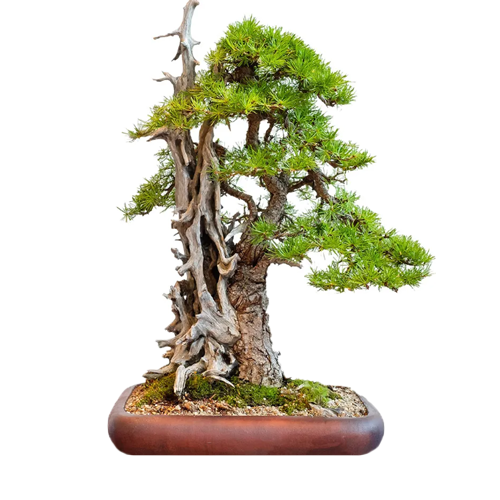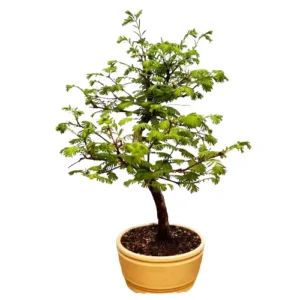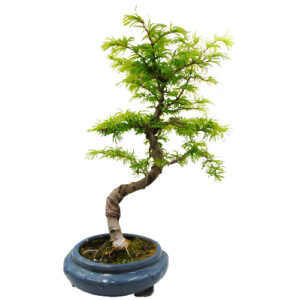Subtotal: £100.00
Pseudolarix Amabilis
Golden Larch Bonsai
The golden larch is native to southeast China and can grow up to 40m in their natural habitat. This species is a deciduous conifer, and they are popular for bonsai because of the deep golden colour their needles turn in autumn before dropping off for winter.

Golden Larch Bonsai Care Tips
Placement
The golden larch is an extremely hardy species that can tolerate harsh conditions well and should be kept outdoors. Look for a spot that receives bright and full sun, it will not thrive indoors. Provide some shade on the hottest of summer days to protect against scorching the needles.
Action does not necessarily need to be taken during the winter and it can be kept outside all year round as these species can survive freezing temperatures down to -20 °C. However, as a bonsai tree is planted in a small pot, it is at risk of freezing over. We recommended providing some frost protection for it by moving it to a cold frame, unheated greenhouse, conservatory, or provide insulation.
Watering
There is no definitive guide to watering and it should be conducted on an observational schedule, not a routine. This means that it is important to keep an eye on the moisture levels of the soil to avoid over and under watering, both which can lead to dropping leaves and/or root death. The amount of water a bonsai requires depends on pot size, climate, airflow, soil and tree type so it is best to use your eyes and fingers to assess whether the soil is damp, wet or dry.
If the top inch or so of soil has dried, it is ready to be watered. When you water, try to get an even coverage over the roots and soil, allowing water to flow out from the bottom of the pot to ensure a good soaking.
If you are a first-time bonsai owner, another way to water is by submerging the entire pot in water until the bubbles stop. If you choose this method, be aware that your bonsai may not need watering for another two to four days, but this will depend on the factors mentioned above such as soil type, pot size and climate.
Feeding & Fertilising
Using fertiliser on your larch will help encourage healthy growth and this should be done periodically from once a week to every two months and only during the growing season. You can start adding Chrysal Liquid Bonsai Feed to your water from March until October and use weekly. Use Naruko Fertiliser Slow Release Bonsai Feed once every one to two months. With Buddhist Pine trees, less is more, and we tend to advise using half the recommended dosage to see how your Buddhist Pine reacts first.
Larches do best with a high nitrogen feed in the early part of spring, just before the buds start growing. Once they have developed vigorously, you should change to a more balanced fertiliser to help it harden off for the winter.
Pruning & Wiring
Pruning your bonsai is important not only to maintain or create an aesthetic style but to also ensure light and airflow can reach inner leaves and the golden larch tolerates constant pruning very well. This is best done in in winter or early spring, before growing starts. New shoots appear very quickly during the larch growing season and can be trimmed back from about 10/15cm to leave just two buds. Undesirable buds should be removed before they open.
Training your bonsai using wiring is best done during the winter dormancy periods when the branches are visible, and the wire can be left on for longest. Larch branches are very pliable and can easily be shaped into most desired styles. Monitor any wiring on the branches during summer as the larch grows fast, and the wire could start to bite into the bark. However, do not worry if the wires do bite in slightly, the shallow marks will grow out within 1-2 years. We recommend using wires with a thickness that matches the thickness of the branch: if the wire you choose is too thick you will damage the bark. If it is too thin, it won’t be effective.
Repotting
Repotting your tree is an important way to provide a fresh and suitable soil mix and ensure appropriate root health. Repot in early spring when the buds begin to extend. Generally, your larch will need to be re-potted once every two years if it is young, while older ones can stay in their pots for longer. However, you should always check if it has become root-bound before you change pots. You can do this by lifting the tree gently out of the pot by the main trunk and examining the root system. You will know it is ready if you can see that the roots are circling around each other and the pot. If, however, they still appear contained in the soil, you should place it back and wait until the following spring to check again.
Trees that are ready for repotting will require root pruning, a suitable new pot and appropriate soil mix.
When repotting, do not cut back the root mass by a large amount, and choose a well-draining soil mix that has a neutral or slightly higher PH value of 5-6 but not over 7. We tend to use a mixture of different speciality bonsai soils on our trees. Every species is different so please contact us for free soil-mix advice or to take advantage of our repotting service.
Bonsai trees aren’t only magnificent additions to an indoor oasis, they are more than capable of standing out in any garden. Many Bonsai species are incredibly hardy and withstand nature’s colder and damper turns with aplomb making them worthwhile outdoor plants. We have an extensive library of care guides for outdoor bonsai trees. It’s not about selecting the perfect bonsai, it’s about selecting the perfect bonsai for you.
Golden Larch Bonsai - Typical Queries
Why are the leaves on my Golden Larch Bonsai turning yellow?
The leaves on your Golden Larch bonsai are turning yellow because they change colour in autumn, a natural phenomenon for this species. The yellow leaves will fall off in winter, leaving the tree bare until spring. This is normal and does not indicate any problem with your tree. However, if the leaves turn yellow at other times of the year, it may be a sign of overwatering, underwatering, nutrient deficiency, or pest infestation.
Do Golden Larch bonsai trees need winter protection?
There is no definitive guide to watering and it should be conducted on an observational schedule, not a routine. This means that it is important to keep an eye on the moisture levels of the soil to avoid over and under watering, both which can lead to dropping leaves and/or root death. The amount of water a bonsai requires depends on pot size, climate, airflow, soil and tree type so it is best to use your eyes and fingers to assess whether the soil is damp, wet or dry.
If the top inch or so of soil has dried, it is ready to be watered. When you water, try to get an even coverage over the roots and soil, allowing water to flow out from the bottom of the pot to ensure a good soaking.
If you are a first-time bonsai owner, another way to water is by submerging the entire pot in water until the bubbles stop. If you choose this method, be aware that your bonsai may not need watering for another two to four days, but this will depend on the factors mentioned above such as soil type, pot size and climate.
What are the benefits of Golden Larch bonsai
Golden Larch bonsai trees have many benefits, such as:
- They are easy to grow and care for, as long as you follow the basic guidelines.
- They are rewarding and satisfying, as you can shape and train them according to your preference and creativity.
- They are relaxing and therapeutic, as they can help you reduce stress and improve your mood.
- They are educational and cultural, as they can teach you about the art and history of bonsai.

 Colourful Blooming Satsuki Azalea 40cm
Colourful Blooming Satsuki Azalea 40cm 


















